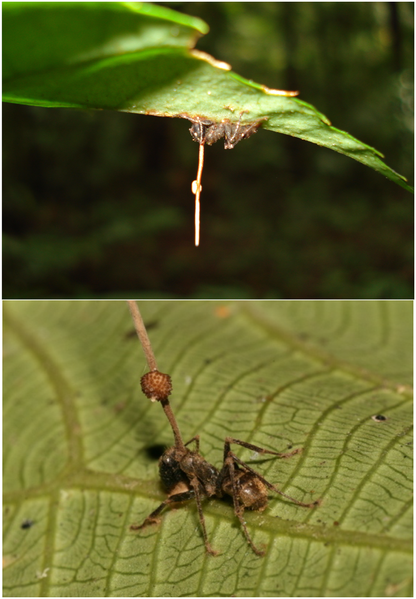The technology isn't in use yet (by humans), but never fear. Nature is here. Biomimetics can serve you, be you mad scientist, disgruntled university student, or Halloween prankster. It's all in the enzymes.
A recent article in the New York Times Science section reviewed the current issue of the Journal of Experimental Biology. The whole issue is dedicated to parasites in nature that turn their hosts into zombies and force them into subservience.
Natural Zombie Example
Picture a harmless little ant, minding its own business as it gathers litter and foodstuff from the forest floor. While the ant is hard at work and unawares, a small spore clings to its exoskeleton and burrows in. The ant doesn't realize anything is wrong, and in the meantime, the spore is slowly eating the soft tissues just underneath the surface. The fungus divides and multiplies several times and little by little, the ant feels an intense desire to climb the nearest plant. It climbs upwards and upwards to the highest leaf, and yields to the emotional need to BITE the leaf. It clamps its mandibles down into the plant's exposed surface, and ... dies. A few days later, the ant's head bursts open, and a stalk erupts forth from the ant's body releasing new spores downward to the forest floor, ready to infect new ants.Creepy? Yes. Perfect mad scientist material, if only you could replicate the process. The secret lies in the enzymes. But, what is an enzyme?
Catalysts
 We mentioned in an earlier post that proteins are the machinery in a cellular factory. Enzymes are proteins that catalyze chemical reactions. To "catalyze" means to "help a reaction happen without being used up". For example, suppose you have chemicals A and B. A and B, when combined, create chemical C. Perhaps the reaction that combines them happens automatically, but very, very slowly. Let's suppose that the reaction that combines A and B to produce C will happen faster if A and B are touching, and if A is negatively charged (has some extra electrons). Finally, let's suppose we have a protein that is shaped just right, so that it has a pocket the shape and size of A, and a nook the shape and size of B, both next to each other. And, let's say this protein has some negatively charged amino acids in the pocket for A. We'll call this hypothetical protein, enzyme R. A and B are attracted to the pockets in R, A picks up a negative charge, and because they're touching, they produce chemical C. The electron jumps back onto enzyme R, and we're done.
We mentioned in an earlier post that proteins are the machinery in a cellular factory. Enzymes are proteins that catalyze chemical reactions. To "catalyze" means to "help a reaction happen without being used up". For example, suppose you have chemicals A and B. A and B, when combined, create chemical C. Perhaps the reaction that combines them happens automatically, but very, very slowly. Let's suppose that the reaction that combines A and B to produce C will happen faster if A and B are touching, and if A is negatively charged (has some extra electrons). Finally, let's suppose we have a protein that is shaped just right, so that it has a pocket the shape and size of A, and a nook the shape and size of B, both next to each other. And, let's say this protein has some negatively charged amino acids in the pocket for A. We'll call this hypothetical protein, enzyme R. A and B are attracted to the pockets in R, A picks up a negative charge, and because they're touching, they produce chemical C. The electron jumps back onto enzyme R, and we're done.R was not used up by the reaction. It just "catalyzed" or "helped along" the reaction so that it would happen faster. There are many mechanisms by which enzymes help reactions happen faster, or keep reactions from happening. As an engineer or scientist, enzymes are useful tools. As a mad scientist, they can help you build your zombie army.
Enzyme Mind Control
Returning to the NY Times article, the author, refers to a similar zombie-mind-control situation, but this time the parasite is a baculovirus, and the host is a caterpillar:"a single gene, known as egt, is responsible for driving the caterpillars up trees. The gene encodes an enzyme. When the enzyme is released inside the caterpillar, it destroys a hormone that signals a caterpillar to stop feeding and molt."
Next time you see this baculovirus deftly manipulate its zombie slave, you can say "I see what you did there!". Just clever use of the central dogma. The baculovirus genome contains a gene. That gene codes for a protein that happens to be an enzyme. That enzyme catalyzes a chemical reaction that breaks down a hormone in the caterpillar's body. By destroying that hormone, the caterpillar suddenly and irresistibly feels the urge to climb a tree. The caterpillar dies and rains new little viruses down on the surrounding area.
Applying What You Know
Now that you know how to make real zombies, you'll be able to answer this young lady's question:And you know that this may not be fictional after all:



No comments:
Post a Comment
We are always glad when someone catches a mistake, has more to add, or just likes our work. Let us know about it!